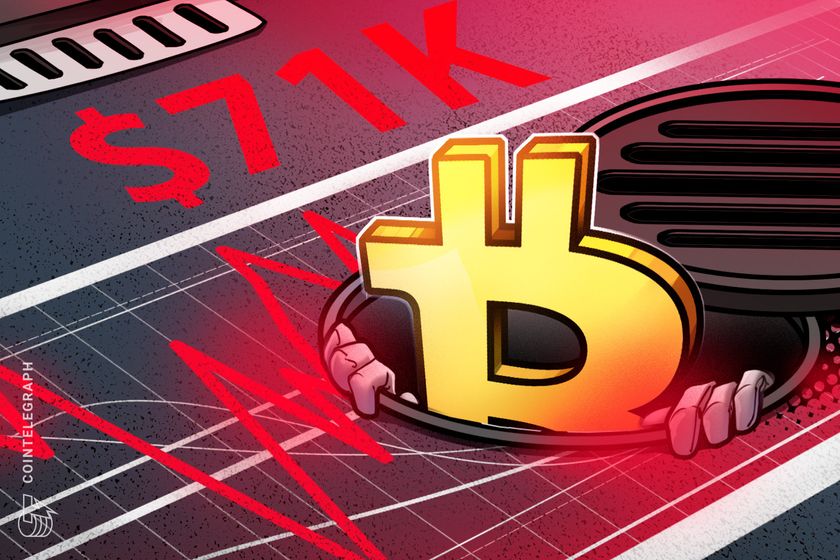




Cryptocurrency listings have outperformed the average of traditional stock listings, despite recent community criticism regarding the manipulation potential of token listings on centralized exchanges.
Token listing procedures on centralized cryptocurrency exchanges (CEXs) drew significant controversy after Changpeng “CZ” Zhao, co-founder and former CEO of Binance, called the process flawed after disappointing performances of some token listings.
Despite the criticism, crypto exchanges have outperformed traditional stock exchanges in terms of listings with positive returns on investment (ROI) and average ROI, according to an April 3 CoinMarketCap report shared exclusively with Cointelegraph.
Over the past 180 days, crypto exchange listings had an average return of over 80%, outperforming the largest traditional stock indexes such as the Nasdaq and Dow Jones, as well as Bitcoin (BTC) and Ether (ETH).
CEX listings, top indexes, average ROI. Source: CoinMarketCap
The 80% return refers to the average performance of all listed tokens by the seven major exchanges, including Binance, Bybit, Coinbase, OKX, Bitget, Gate and KuCoin.
Moreover, 68% of crypto exchange listings boasted a positive ROI, outperforming the New York Stock Exchange’s (NYSE) 54% and the Nasdaq’s 51%.
Source: CoinMarketCap
“This data suggests that crypto exchanges have made progress in refining their listing,” the report said.
Related: 70% chance of crypto bottoming before June amid trade fears: Nansen
Cryptocurrencies listed on CEXs generally see high demand from investors as the exchanges provide significant new liquidity that can boost the coins’ price performances after listing.
Token-listing criteria on CEXs started garnering attention in November 2024, after Tron founder Justin Sun claimed that Coinbase allegedly asked for $330 million in total fees to list Tron (TRX), a surprising allegation since Coinbase claims to charge no fees for listing new cryptocurrencies.
Related: Trump-linked crypto ventures may complicate US stablecoin policy
Token listing performance still depends on broader market conditions: Binance
Recent investor disappointment with some token listings may stem from historic profit expectations due to the significant upside of numerous CEX-listed tokens.
Still, the returns of a cryptocurrency after listing depend on the wider market appetite, a Binance spokesperson told Cointelegraph, adding:
“Outcomes can vary depending on broader market conditions. As the industry matures, we’re seeing reduced volatility compared to earlier cycles — a shift that reflects greater stability and long-term sustainability in the crypto market.”
“Crypto investors’ expectations for new listings to perform well are understandable and often shaped by the historic success” of CEX listings, added the spokesperson.
Binance, the world’s largest crypto exchange, listed 77 cryptocurrencies throughout 2023 and 2024, with a 0% delisting rate.
Binance announced a community voting mechanism for token listings on March 9, to make the listing process more decentralized.
Magazine: Memecoins are ded — But Solana ‘100x better’ despite revenue plunge

Founder & CEO of Professional Capital Management, Anthony Pompliano has praised the new tariffs introduced by President Donald Trump on Wednesday, arguing that they highlight the inefficiencies of traditional financial systems and bolster the case for decentralized finance solutions like Bitcoin (CRYPTO: BTC).
What Happened: Speaking on a podcast, Pompliano linked the tariffs to broader economic shifts, while the crypto market faced significant declines amid fears of a global trade war sparked by the new policy.
Pompliano emphasized that the tariffs underscore the vulnerabilities of centralized banking systems, which he claims have been weaponized against businesses for political reasons.
He recounted the Trump family’s experience with banks like Capital One, Chase, Bank of America and First Republic, which canceled their accounts during Donald Trump‘s presidency, a move he described as “political lawfare.”
This experience, shared by Eric Trump on the same broadcast, drove the family to embrace cryptocurrency.
“I realized the power that these banks had, and I realized how they were exerting that power, and they were canceling businesses all over our country,” Eric Trump said, explaining his shift toward crypto.
The tariffs, …




The US Treasury Department sanctioned eight cryptocurrency wallet addresses linked to Russian crypto exchange Garantex and the Houthis.
The United States Office of Foreign Assets Control (OFAC) sanctioned eight crypto addresses that data from blockchain forensic firms Chainalysis and TRM Labs had linked to the organizations. Two are deposit addresses at major crypto platforms, while the other six are privately controlled.
Visualization of transaction flow related to OFAC sanctions. Source: Chainalysis
The addresses in question reportedly moved nearly $1 billion worth of funds linked to sanctioned entities. Most of the transactions funded Houthi operations in Yemen and the Red Sea region.
Slava Demchuk, a crypto-focused money laundering specialist and United Nations Office on Drugs and Crime consultant told Cointelegraph that “the inclusion of Houthi-linked wallets reflects a broader recognition of crypto’s role in geopolitical conflicts and terrorism financing.” He added:
“The implications are far-reaching — compliance frameworks must adapt swiftly, attribution efforts will intensify, and decentralized platforms may face increased scrutiny.“
Demchuk highlighted that the situation reshapes the regulatory landscape. According to him, crypto “is now firmly within the scope of international security.
Who are the Houthis?
The Houthis, also known as Ansar Allah, are a Yemeni political and armed movement that emerged from the Zaidi Shia community. Originating as a revivalist and reformist group, they later became a major force in Yemen’s ongoing conflict.
Related: US DOJ says it seized Hamas crypto meant to finance terrorism
In recent years, the Houthis have engaged in attacks against both military and civilian vessels in the Red Sea with missiles and drones. In January, US President Donald Trump designated the group as a foreign terrorist organization.
The announcement noted that “the Houthis’ activities threaten the security of American civilians and personnel in the Middle East, the safety of our closest regional partners, and the stability of global maritime trade.” The group was recently struck by a US bombing campaign.
Related: Binance claims’ no special relationship’ with Hamas, argues to dismiss lawsuit
Garantex: Russia’s crypto laundromat
Garantex is a Russian crypto exchange that was sanctioned and shut down in early March after purportedly helping money-laundering efforts. At the time, Tether — the leading stablecoin operator and issuer of USDt — froze $27 million in USDt on the platform, forcing it to halt operations.
The platform has reportedly shifted millions of dollars as it sought to reboot under its new brand, “Grinex.”
In mid-March, officials with India’s Central Bureau of Investigation announced the arrest of Lithuanian national Aleksej Bešciokov, who was alleged to have operated the cryptocurrency exchange Garantex.
The arrest of the alleged Garantex founder was based on US charges of conspiracy to commit money laundering, conspiracy to operate an unlicensed money-transmitting business and conspiracy to violate the International Emergency Economic Powers Act.
Magazine: Financial nihilism in crypto is over — It’s time to dream big again




Binance co-founder Changpeng “CZ” Zhao donated over half a million dollars worth of crypto to the earthquake disaster relief effort in Thailand and Myanmar, in another testament to the growing utility of blockchain-based emergency charity efforts.
Zhao donated 1,000 BNB (BNB) tokens worth almost $600,000 to the disaster relief funds for the region on March 3, blockchain data shows.
Zhao donates 1,000 BNB. Source: BscScan
“Sent 1000 BNB for the donation for Myanmar and Thailand,” wrote Zhao in an April 3 X post.
The crypto donation comes after Thailand and Myanmar were hit by a 7.7 magnitude earthquake on March 28, causing severe damage to buildings and widespread flooding.
Related: 70% chance of crypto bottoming before June amid trade fears: Nansen
At least 2,719 people have been confirmed dead in Myanmar and 18 in Thailand, with 76 people still unaccounted for, according to the latest figures shared by Reuters.
The $600,000 donation comes nearly a week after Zhao pledged to donate 500 BNB for the relief efforts, an initial commitment that he doubled. Cryptocurrency-based donations have emerged as a significant lifeline for the region, due to banking restrictions caused by damaged infrastructure.
Source: The Giving Block
Crypto donations exceeded $1 billion in 2024, spurred by increasing digital asset valuations and growing crypto regulatory clarity. About 16% of the donations went toward education, while 14% went toward medicine and health-related efforts.
The Giving Block has launched a crypto-based emergency relief effort for Myanmar and Thailand to raise $500,000 for the devastated region.
Source: TheGivingBlock
The organization expects crypto donations to reach $2.5 billion in 2025 on growing crypto wealth generation and increasing adoption due to a more favorable political landscape.
Related: Trump-linked crypto ventures may complicate US stablecoin policy
Crypto donations gain traction for emergency relief efforts
Zhao’s donation is a testament to the growing role of cryptocurrency in humanitarian aid, according to Anndy Lian, author and intergovernmental blockchain expert.
“Crypto donations, compared to traditional fiat contributions, offer unique advantages, especially in emergencies,” Lian told Cointelegraph, adding:
“Speed is a key factor—transactions on blockchain networks can settle in minutes, bypassing the delays of banks or intermediaries, which is critical when time saves lives.”
“In disaster-stricken areas like Myanmar or Thailand, where infrastructure might be compromised, crypto can reach recipients directly via digital wallets, no SWIFT codes or wire transfers required,” Lian explained.
Source: Anndy Lian
Lian also donated 44 BNB tokens to the relief efforts in Myanmar and Thailand, a move that was publicly praised by Zhao.
Ethereum co-founder Vitalik Buterin has been known for his crypto donations. In October, Buterin donated over $180,000 in Ether (ETH) to the biotech charity Kanro.
Magazine: GUN token’s $69M milestone, Pudgy Penguins go to LOL Land: Web3 Gamer






Bitcoin (BTC) faces “very high risk” conditions from US trade tariffs, which could spark a slump to $71,000.
In his latest analysis, Charles Edwards, the founder of quantitative Bitcoin and digital asset fund Capriole Investments, warned about the impact of “higher than expected” US trade tariffs.
”Higher than expected” US tariffs pressure Bitcoin
Bitcoin reacted noticeably worse than US stocks after President Donald Trump announced worldwide reciprocal trade tariffs on April 2.
BTC/USD fell up to 8.5% on the day, while the S&P 500 managed to end the Wall Street trading session 0.7% higher.
Edwards said that US business expectations are reflecting the type of uncertainty seen only three times since the turn of the millennium.
“Consider this as tariffs come in higher than expected. The Philly Fed Business Outlook survey is showing expectations today comparable to 2000, 2008 and 2022,” he told X followers.
An accompanying chart showed the Philadelphia Fed’s Business Outlook Survey (BOS) back under 15 for the first time since the start of 2024. Late 2022 was the pit of the most recent crypto bear market when BTC/USD reversed at $15,600.
Philadelphia Fed Business Outlook Survey vs. S&P 500. Source: Charles Edwards/X
In Capriole’s latest market update on March 31, Edwards acknowledged that BOS data can produce unreliable signals regarding market sentiment but argued that it should not be ignored.
“While no guarantee of the future outlook (this metric does have false signals) this is a data reading we have had before at very high risk zones (year 2000, 2008 and 2022), telling us to keep a very open mind,” he wrote, adding:
“Especially if the tariff war escalates significantly beyond current expectations or corporate margins start to fall.”
For Bitcoin, a key level to watch in the tariff aftermath is $91,000, with Capriole suggesting that US macroeconomic moves would “decide the ultimate technical trend from here.”
“All else equal, a daily close above $91K would be a strong bullish reclaim signal,” the update explained alongside the weekly BTC/USD chart.
“Failing that, a dip into the $71K zone would likely see a sizable bounce.”
BTC/USD 1-day chart (screenshot). Source: Capriole Investments
BTC price focus on US liquidity trend
As Cointelegraph reported, a silver lining for crypto and risk assets could come in the form of increasing global liquidity.
Related: Bitcoin sales at $109K all-time high ‘significantly below’ cycle tops — Glassnode
In the US, the Fed has already begun to loosen tight financial policy, with bets on a return to so-called quantitative easing (QE) varying.
“How long until the Powell printer starts humming?” Edwards queried.
M2 money supply, meanwhile, is due for an “influx,” something which has historically spawned major BTC price upside.
“The BIG takeaway (the most important observation) is that a big M2 influx is coming. The exact date is less important,” analyst Colin Talks Crypto predicted in an X thread this week.
A comparative chart hinted at a potential BTC price rebound by the start of May.
US M2 money supply vs BTC/USD chart. Source: Colin Talks Crypto/X
This article does not contain investment advice or recommendations. Every investment and trading move involves risk, and readers should conduct their own research when making a decision.

